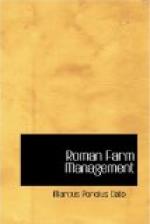Even here in this pleasant region, where night and day revolve punctually, I am not able to live in summer unless I divide the day with my appointed midday nap. How is it possible to plant or to cultivate or to harvest any thing there where the days and nights are six months long. On the other hand, what useful thing is there which does not only grow but flourish in Italy? What spelt shall I compare with that of Campania? What wheat with that of Apulia? What wine with that of Falernum? What oil with that of Venafrum? Is not Italy so covered with fruit trees that it seems one vast orchard? Is Phrygia, which Homer calls [Greek: ampeloessa], more teeming with vines, or is Argos, which the same poet calls [Greek: polupuros] more rich in corn?[47] In what land does one jugerum produce ten, nay even fifteen, cullei of wine, as in some regions of Italy? Has not M. Cato written in his book of Origines ’That region lying this side of Ariminium and beyond Picenum, which was allotted to colonists, is called Roman Gaul. There in several places a single jugerum of land produces ten cullei of wine.’ Is it not the same in the region of Faventia where the vines are called tre centaria because a jugerum yields three hundred amphorae of wine,” and, looking at me, he added, “indeed L. Martius, your chief engineer, said that the vines on his Faventine farm yielded that much.[48] The Italian farmer looks chiefly for two things in considering a farm, whether it will yield a harvest proportioned to the capital and labour he must invest, and whether the location is healthy. Whoever neglects either of these considerations and despite them proposes to carry on a farm, is a fool and should be taken in charge by a committee of his relatives.[49] For no sane man is willing to spend on an agricultural operation time and money which he knows he cannot recoup, nor even if he sees a likely profit, if it must be at the risk of losing all by an evil climate.
“But there are here present those who can discourse on this subject with more authority than I, for I see C. Licinius Stolo and Cn. Tremelius Scrofa approaching. It was the ancestor of the first of these who brought in the law for the regulation of land-holding; for the law which forbade a Roman citizen to own more than 500 jugera of land was proposed by that Licinius who acquired the cognomen of Stolo on account of his diligence in cultivating his land: he is said to have dug around his trees so thoroughly that there could not be found on his farm a single one of those suckers which spring up from the ground at the roots of trees and are called stolones. Of the same family was that other C. Licinius who, when he was tribune of the people, 365 years after the expulsion of the Kings, first transferred the Sovereign function of law making from the Comitium to the Forum, thus as it were constituting that area the ‘farm’ of the entire people.[50] The other whom I see come hither is Cn. Tremelius Scrofa, your colleague on the Committee of Twenty for the division of the Campanian lands, a man distinguished by all the virtues and considered to be the Roman most expert in agriculture.[51]




